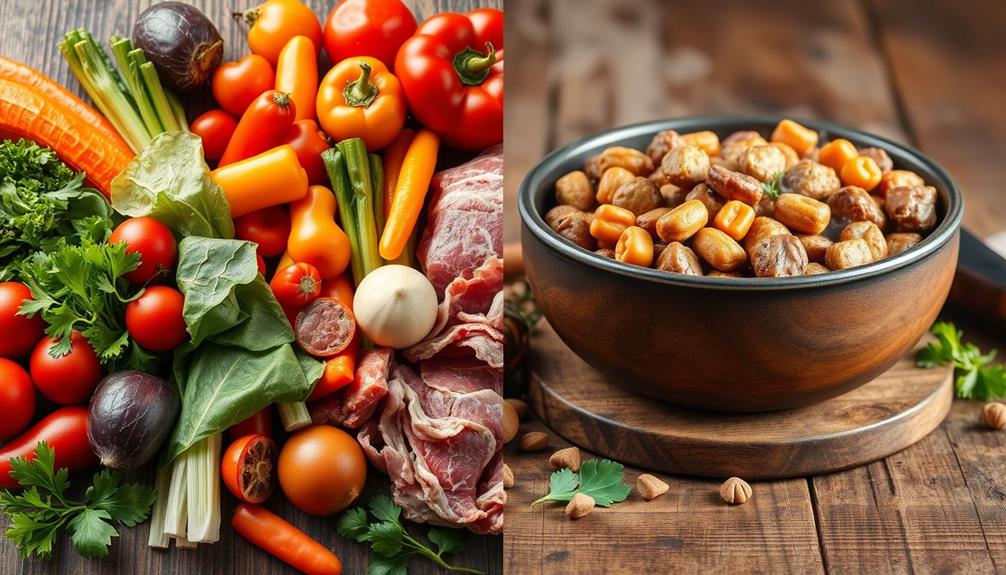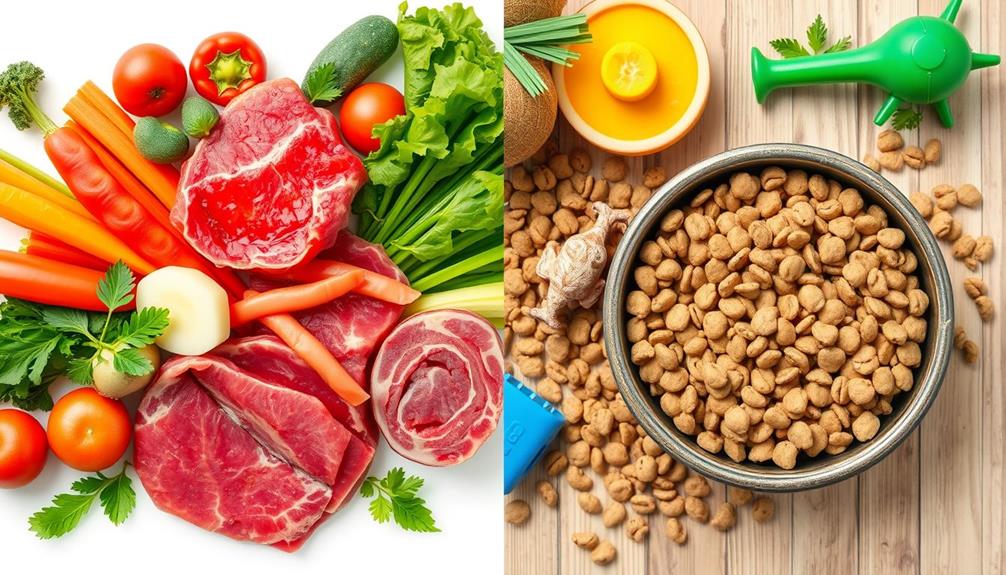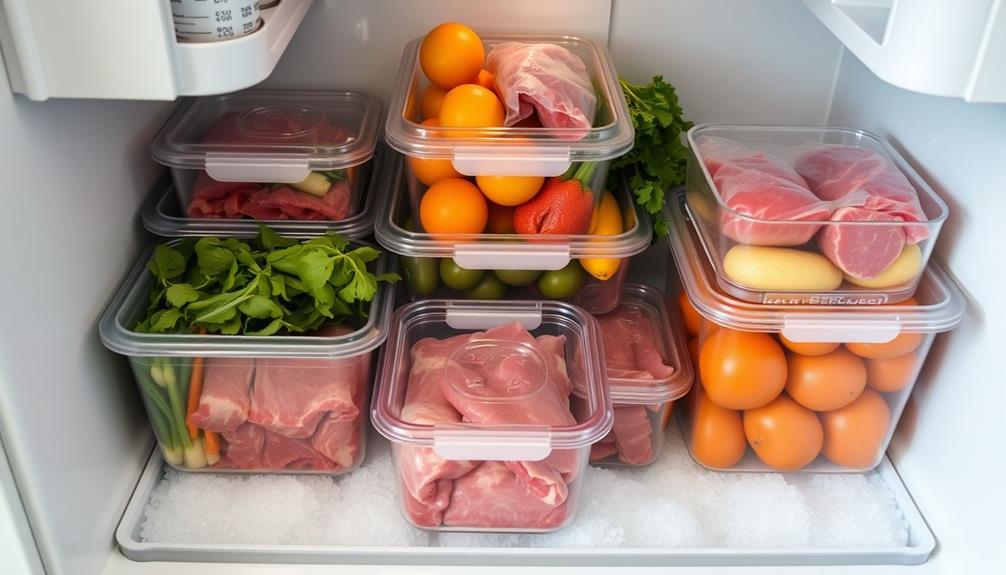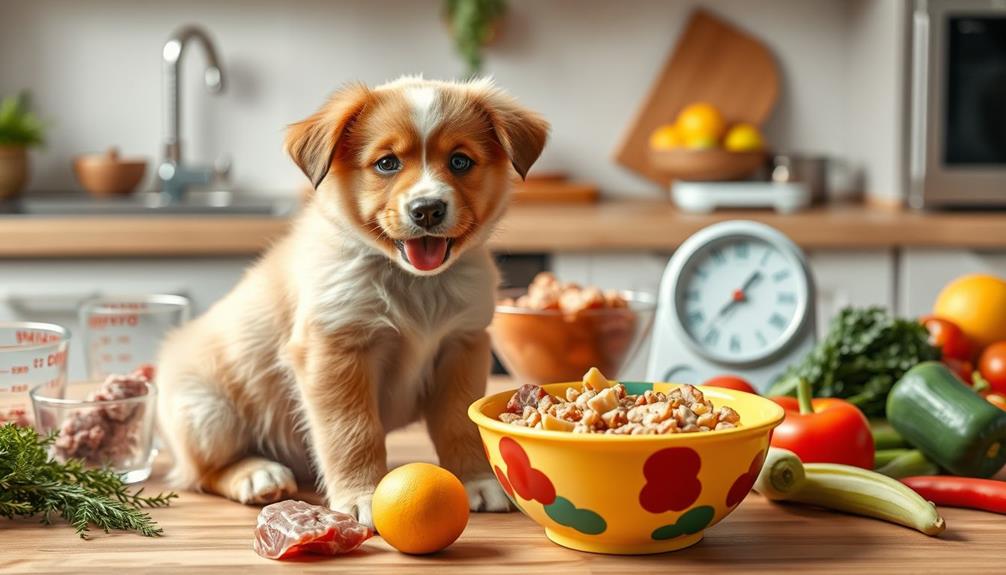When deciding between raw food and cooked food for your dog, consider their nutritional needs and safety. Raw diets often retain more nutrients and improve coat and dental health, while cooked meals can enhance digestibility and reduce health risks from pathogens. Both can offer benefits, like increased energy on raw diets or better weight management with cooked options. However, your lifestyle and convenience also play a role. Understanding these factors can help you choose the best fit for your furry friend. There's much more to explore about each diet's pros and cons to guide your decision. If you have a puppy, it’s important to consider the potential risks of raw food, as their immune systems may not be fully developed to handle any potential pathogens. However, raw food for puppies can also provide essential nutrients for their growth and development. It’s essential to consult with a veterinarian to determine the best feeding option for your puppy based on their individual needs and health status.
Key Takeaways
- Raw food diets retain more natural nutrients and can improve coat condition, while cooked food enhances digestibility and reduces pathogen risks.
- Safety practices for raw food include hygiene measures and proper storage temperatures; cooked food requires cooking to safe temperatures and avoiding cross-contamination.
- Health benefits of raw diets may include increased energy, while cooked diets offer peace of mind and better weight management.
- Cost and accessibility can affect diet choices, with raw diets often being pricier due to high-quality ingredients compared to cooked meals.
- Gradual transitions between diets and veterinary consultations are crucial for ensuring nutritional balance and addressing health concerns.
Nutritional Value Comparison
When considering your dog's diet, it's vital to understand the nutritional value differences between raw and cooked food. Raw food diets often retain more natural nutrients, enzymes, and amino acids. In contrast, the cooking process can lead to nutrient loss due to high heat, impacting the overall nutritional quality of cooked dog food.
Incorporating essential oils for health benefits, such as essential oils for respiratory health, can also complement your dog's diet and well-being. Research shows that whole food diets, whether raw or cooked, generally offer better digestibility than processed kibble. Notably, the digestibility of raw food tends to be higher, which means your dog may absorb more essential nutrients from raw ingredients than from their cooked counterparts. Nutrient bioavailability is also a significant factor; raw food diets typically allow for greater absorption of these nutrients.
On the other hand, freshly cooked foods can provide a balanced diet of proteins, carbohydrates, and fats. However, some cooked diets may require synthetic additives to replace lost nutrients.
If you choose to go the raw route, remember that a properly formulated raw diet can meet your dog's natural dietary needs, but nutritional imbalances can occur if it's not carefully planned.
Safety and Preparation Practices
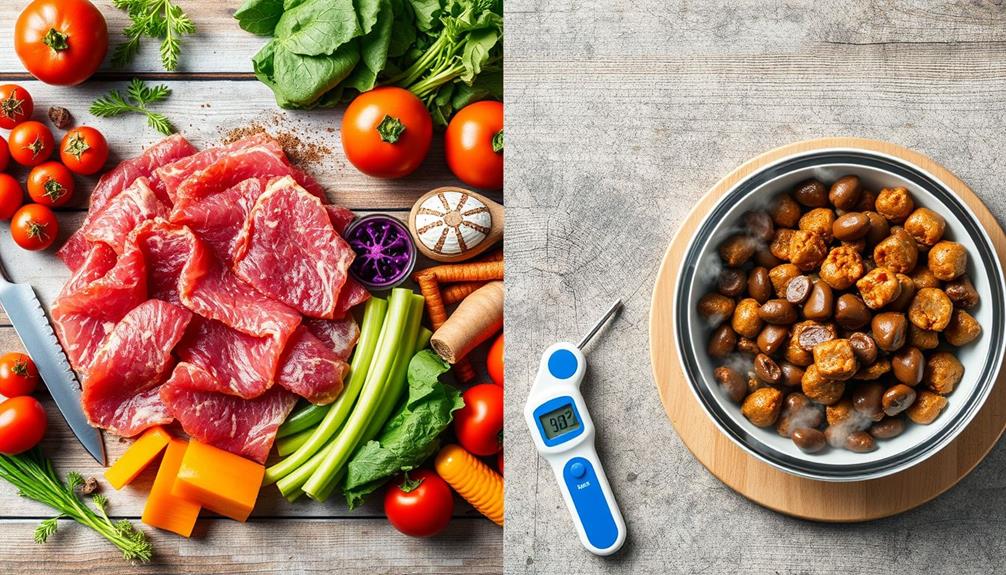
When deciding between raw and cooked diets for your dog, safety and preparation practices are key.
You need to follow strict hygiene measures with raw food to prevent bacteria like Salmonella, while cooked options can offer a safer alternative.
Regular cleaning of your dog's feeding area is essential to prevent contamination, much like maintaining a clean environment for hamster care.
Understanding proper cooking methods and storage guidelines will help you keep your furry friend healthy and thriving.
Raw Food Hygiene Practices
Handling raw food for dogs requires strict hygiene practices to guarantee safety and prevent bacterial contamination. Always start by cleaning your hands, utensils, and surfaces thoroughly before and after preparing raw meat. This minimizes the risk of cross-contamination, which is especially important if you have vulnerable individuals in your household.
Additionally, it's advisable to take into account the potential side effects and interactions of any supplements you may add to your dog's diet, as cold medications overview can inform you about safety and effectiveness.
Store raw food at ideal temperatures, ideally below 40°F, to prevent spoilage and guarantee safety. Dispose of any uneaten portions promptly to inhibit pathogen growth.
When incorporating fruits and vegetables into your dog's diet, wash them thoroughly to eliminate pesticide residues and bacteria.
It's vital to follow safe raw feeding practices, so don't hesitate to consult veterinary professionals for guidance. They can help you create a balanced diet that meets your dog's nutritional needs while managing the complexities of raw feeding.
Cooking Methods for Safety
Cooking methods play an essential role in guaranteeing your dog's meals are both safe and nutritious. By using techniques like boiling, steaming, or lightly sautéing, you can eliminate harmful pathogens such as Salmonella and E. coli, while also preserving the nutritional value of the ingredients.
It's vital to implement safe cooking practices to avoid cross-contamination and guarantee that all components are cooked to the right temperatures. Additionally, maintaining a clean environment during food preparation can help reduce the risk of foodborne illnesses, much like how proper air purifier maintenance enhances indoor air quality.
Consider these safe cooking practices:
- Always cook ingredients to a minimum of 165°F (74°C) to kill bacteria effectively.
- Avoid cross-contamination by using separate utensils for raw and cooked dog food.
- Regularly clean cooking surfaces and utensils to minimize contamination risks.
- Store cooked dog food in the refrigerator within two hours to prevent spoilage.
When you prepare cooked dog food with these methods, you're not only prioritizing safety but also enhancing your dog's health.
Safe Storage Guidelines
Storing your dog's food properly is essential for their health and safety. For raw dog food, keep it at temperatures below 40°F (4°C) to prevent bacterial growth.
Daily consumption of certain foods, like cranberry juice consumption, may impact overall health, and the same principle applies to your dog's diet. If your pup doesn't finish their meal, discard any uneaten portions immediately to minimize health risks.
When it comes to cooked dog food, you can safely store it in the refrigerator for up to 3-5 days. If you want longer shelf life, freezing it can be an excellent option, typically lasting up to 3 months.
Always remember to handle raw food with care. Use separate utensils and cutting boards to avoid cross-contamination with other foods.
When you thaw frozen raw dog food, do it in the refrigerator, never at room temperature, to reduce the risk of bacterial proliferation.
For cooked dog food, allow it to cool to room temperature before refrigerating. You can gently reheat it to guarantee nutritional preservation, but avoid overheating, as this can diminish the benefits.
Health Benefits of Each Diet
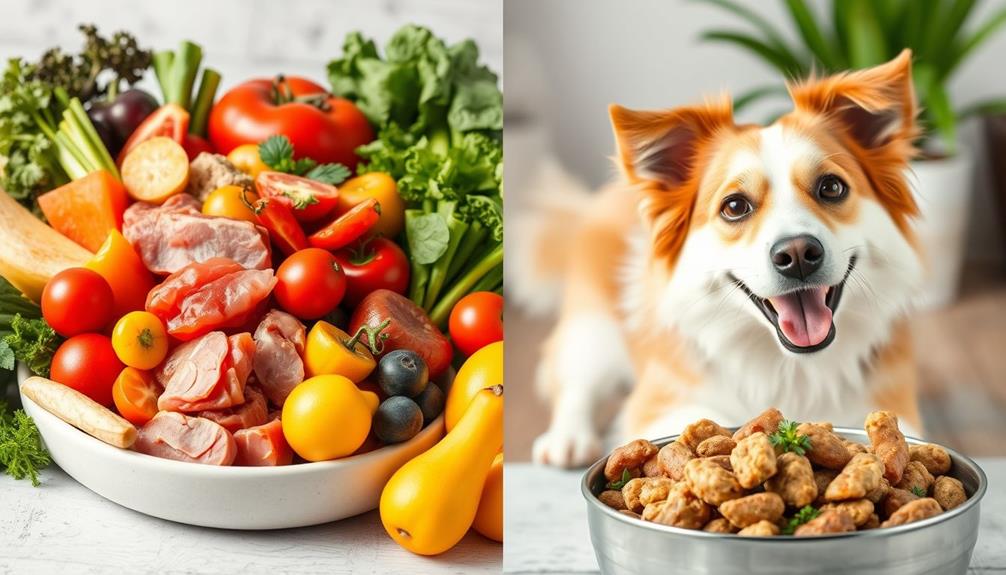
When it comes to choosing between raw and cooked diets for your dog, both options offer unique health benefits that cater to their specific needs. While a raw diet may provide dogs with nutrients that are often lost during the cooking process, there are potential risks associated with raw meat, such as bacterial contamination. Many pet owners wonder, ‘is raw food safe for dogs?’ It is important to carefully research and consult with a veterinarian before making the decision to switch to a raw diet, as it may not be suitable for every canine companion. Ultimately, the best diet for a dog depends on their individual health and nutritional needs.
Raw diets can enhance your dog's coat condition and skin health, largely due to their high omega fatty acid content, which is similar to the benefits of herbs like chamomile and ginger in promoting overall well-being. Many owners report that their dogs seem more energetic and vibrant when fed a balanced raw food diet, which may contribute to an overall healthier lifestyle.
Additionally, the natural chewing of raw meat and bones aids in dental health by reducing plaque buildup.
On the other hand, cooked diets provide their own set of advantages. They can minimize the risk of foodborne illnesses, as cooking eliminates harmful pathogens often found in raw meat.
Moreover, freshly cooked meals allow for better weight management, enabling you to control calorie intake and tailor nutritional balance according to your dog's needs.
Here are some key benefits to take into account:
- Improved coat and skin health with raw diets
- Enhanced energy levels from raw food
- Reduced risk of foodborne illnesses with cooked meals
- Controlled calorie intake for effective weight management
Both diets can be beneficial, depending on your dog's individual situation.
Cost and Accessibility Factors
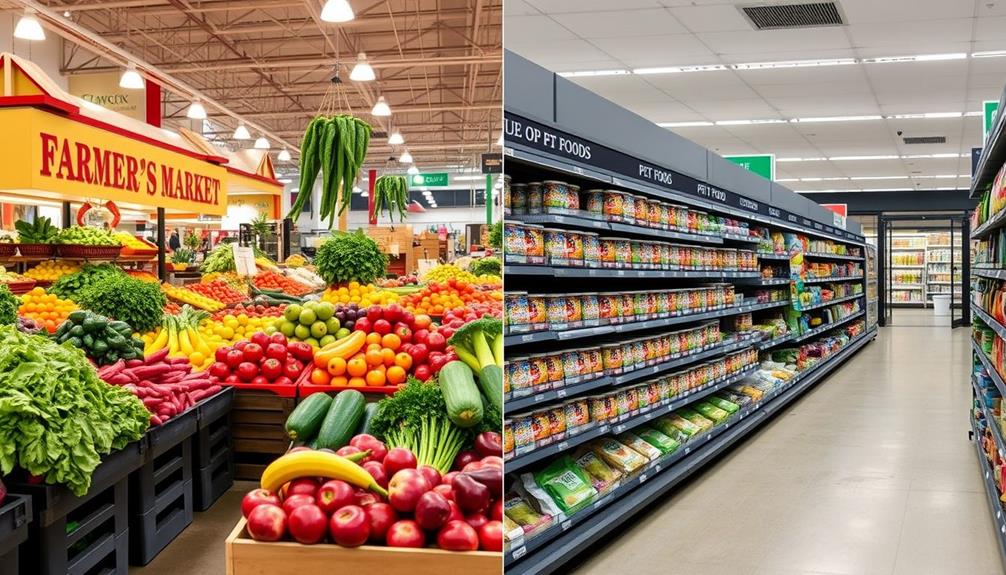
Choosing a diet for your dog involves not just health considerations but also cost and accessibility factors. Raw food diets can often be pricier due to the need for high-quality, fresh ingredients sourced from reputable suppliers. This can lead to higher overall costs compared to cooked diets, especially if you're preparing meals at home.
Additionally, considering your overall financial health, it's vital to understand the potential impact on your budget before committing to a specific diet approach, as creating a budget plan can help in managing these expenses effectively.
Accessibility also plays a vital role; in some regions, finding premium raw ingredients can be challenging, limiting your options for maintaining a raw diet. On the other hand, while pre-packaged cooked meals provide convenience, they can carry a hefty price tag, making them less cost-effective for long-term feeding.
For those mindful of their budget, homemade cooked meals can be a viable alternative. They allow you to control the quality of ingredients while potentially lowering your overall costs.
Ultimately, budget considerations are essential when deciding between raw and cooked diets, as you'll want to balance dietary quality with what fits within your financial means. Remember, it's important to choose a diet that suits both your dog's health needs and your wallet.
Owner Preferences and Lifestyle Choices
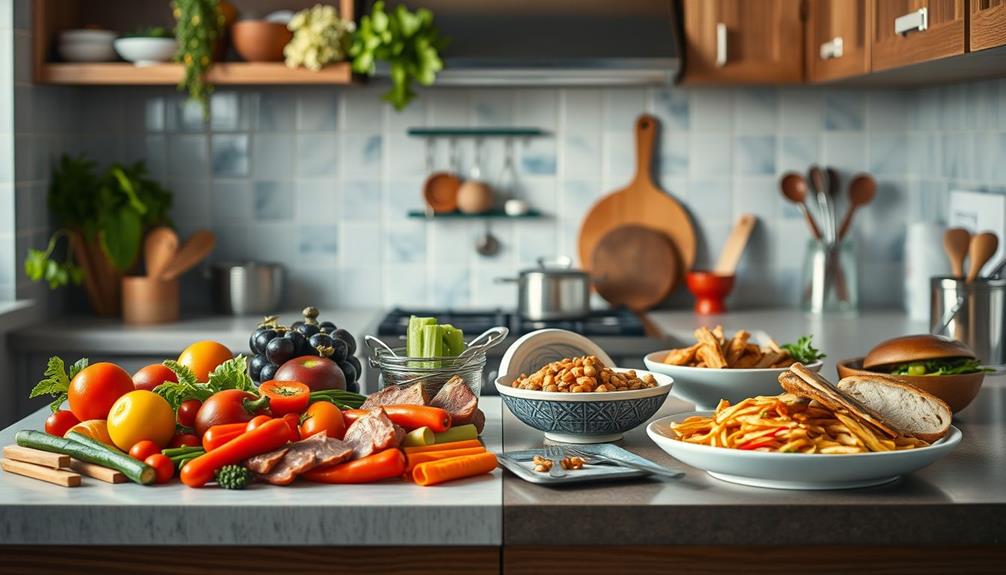
When choosing between raw and cooked food for your dog, your personal beliefs about nutrition and animal welfare play a huge role.
It's important to evaluate the nutritional needs of your dog, as financial considerations for elderly care can often parallel the importance of budgeting for quality pet food.
You also have to assess your lifestyle; if you're busy, freshly cooked meals might be more convenient than sourcing and preparing raw ingredients.
Ultimately, finding the right balance between your values and your dog's needs is key to their health and happiness.
Dietary Preferences and Beliefs
Many dog owners find that their dietary preferences and beliefs heavily influence the type of food they choose for their pets. Your views on animal welfare, health, and nutrition often shape whether you lean towards raw food or cooked meals. High-quality ingredients are essential for ensuring ideal nutrition, regardless of your choice.
Understanding how key domains of development in psychology can influence behavior may also play a role in how you perceive your pet's dietary needs.
Consider these key points when choosing your dog's diet:
- Individual dog preferences: Some dogs may thrive on raw diets, while others prefer the taste of cooked meals.
- Education on canine nutrition: Understanding what your dog needs helps you make informed decisions about their diet.
- Commitment and convenience: Raw feeding requires effort in sourcing and preparing specific ingredients, which can be challenging for busy owners.
- The role of high-quality ingredients: Prioritizing nutrition is vital for your dog's health.
Ultimately, your decisions are influenced by both your beliefs and your dog's individual preferences. Striking a balance between convenience and nutrition will lead to a healthier, happier pet.
Lifestyle Convenience Considerations
Your lifestyle and preferences play a significant role in determining what you feed your dog. For busy owners, convenience is essential. Raw food diets require a substantial commitment to sourcing, preparing, and safely handling ingredients, which can be overwhelming. In contrast, freshly cooked meals can be tailored to fit your schedule, making it easier to portion and serve without the strict hygiene practices associated with raw feeding.
Here's a quick comparison to evaluate:
| Aspect | Raw Food Diets | Freshly Cooked Meals |
|---|---|---|
| Convenience | Requires significant prep time | Quick and easy to prepare |
| Risk of Foodborne Illnesses | Higher risk, needs careful handling | Lower risk, easier hygiene |
| Budget Considerations | Often more expensive | Can be budget-friendly |
Many dog owners lean towards cooked diets due to the reduced risk of foodborne illnesses, especially in homes with children or the elderly. Additionally, your dog's individual preferences may vary, so observing their reactions can help you achieve ideal adherence to the chosen diet. Ultimately, weigh these factors to find the best feeding option for your furry friend.
Overview of Raw Feeding
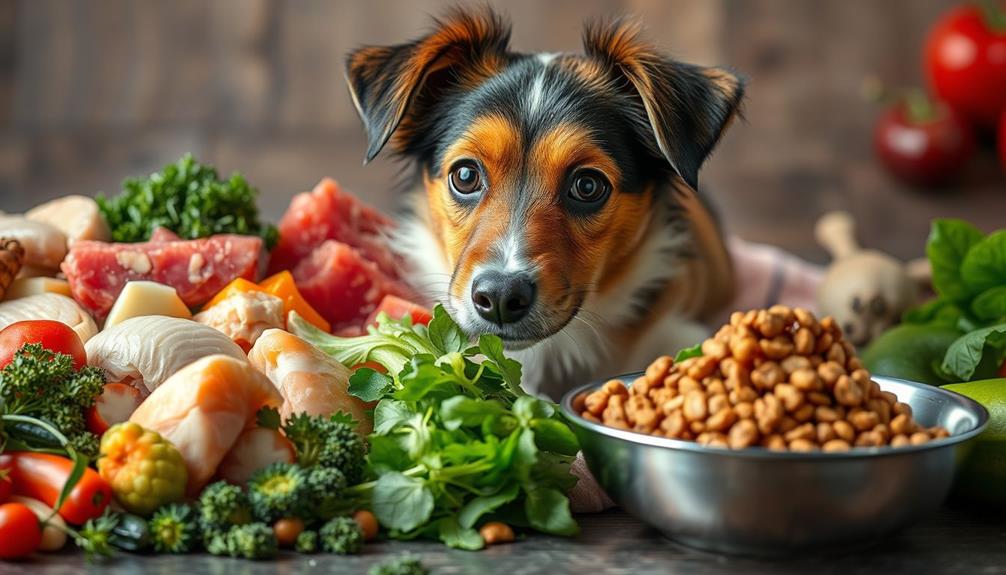
Raw feeding offers an alternative approach to canine nutrition by providing dogs with uncooked foods like meat, bones, fruits, and vegetables. Proponents believe this diet can enhance health by improving coat condition and digestion, while also presenting potential for better nutrient absorption compared to some cooked options.
However, ensuring nutritional balance is vital, as raw diets can lead to deficiencies if not managed properly. It's important to consult with veterinarians to create a well-rounded meal plan that considers the specific needs of your dog and the potential risks involved, such as food safety risks due to pathogens in raw meat.
When considering raw feeding, keep these points in mind:
- Cooking may reduce vital nutrients that dogs need.
- Raw diets can pose food safety risks due to pathogens in raw meat.
- Shifting to a raw diet should be gradual to avoid gastrointestinal upset.
- Proper food handling and sanitation practices are fundamental to minimize health risks.
While raw feeding can offer benefits, it's important to weigh these against the potential risks associated with cooked diets for dogs. Understanding the implications of pathogens and nutritional balance will help you make informed decisions about your dog's diet.
Advantages of Cooked Dog Food
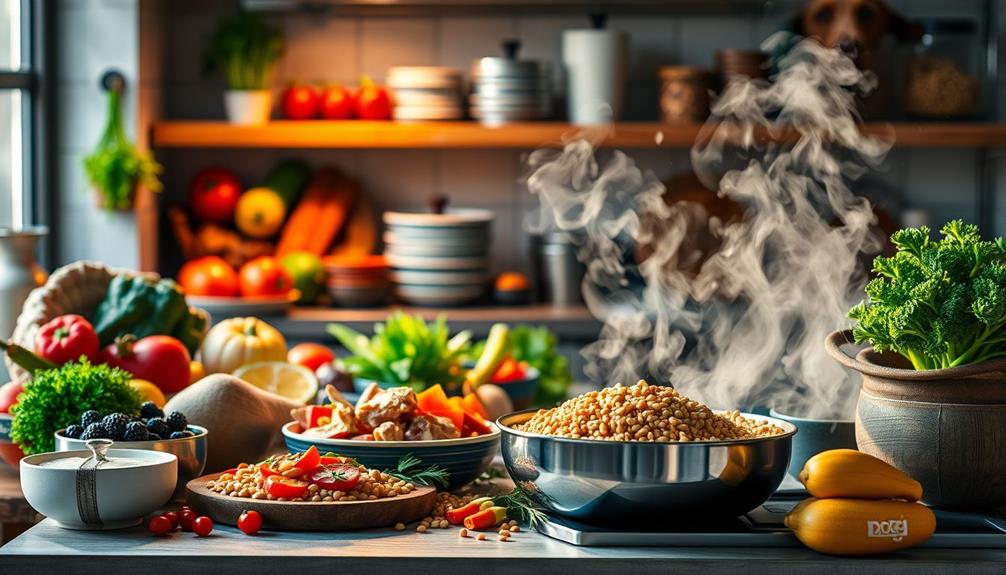
One major advantage of cooked dog food is its ability to greatly reduce the risk of bacterial contamination, such as Salmonella and Listeria. This focus on food safety makes it a safer option for households, especially those with vulnerable individuals.
Gently cooked meals can also enhance digestibility and nutrient absorption, easing your dog's shift from commercial kibble to a homemade diet.
When you prepare homemade cooked meals, you gain the flexibility to create personalized dietary choices that cater to your dog's specific health needs and preferences. This customization guarantees your pet gets a balanced diet, avoiding the preservatives and fillers often found in commercial kibble.
Moreover, cooking extends the shelf life of dog food, making it more convenient to store and serve compared to raw options. You can batch-cook meals and keep them ready for your dog, guaranteeing they always have fresh, nutritious food on hand.
With cooked dog food, you not only promote your pet's health but also enjoy peace of mind knowing you're providing a safe, wholesome option tailored just for them.
Considerations for a Raw Diet
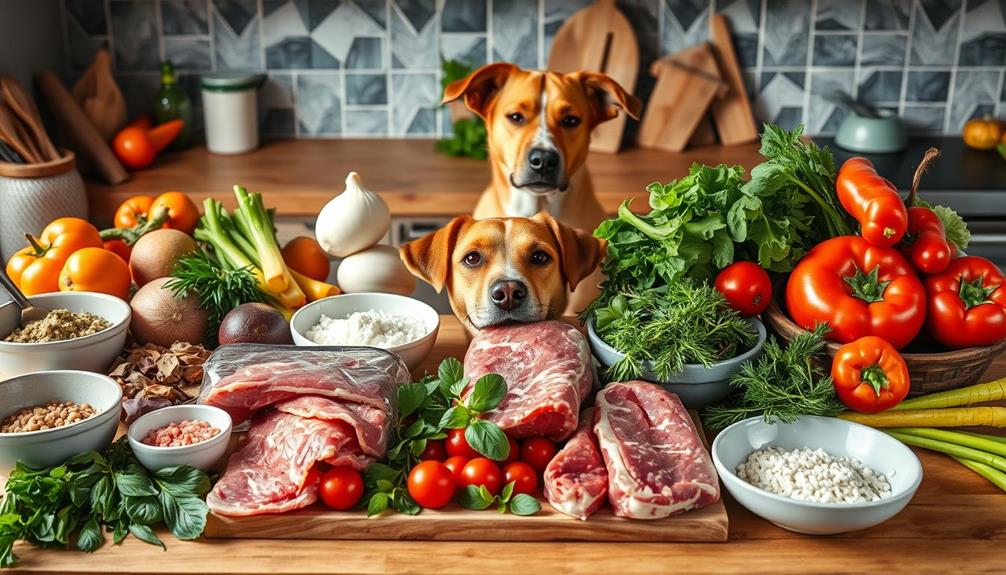
When considering a raw diet for your dog, it's important to recognize that it requires careful planning and attention to detail. A balanced raw dog food diet must include a variety of protein sources, organ meats, and dog-safe fruits and vegetables to meet your dog's nutritional needs.
Additionally, consultation with a veterinarian or a pet nutritionist is essential to prevent nutritional imbalances and guarantee the diet is formulated correctly for your dog.
Here are some key considerations:
- Nutrition: Verify the diet provides essential amino and fatty acids.
- Food Safety: Implement strict hygiene practices to prevent contamination with pathogens like Salmonella and E. coli.
- Gastrointestinal Upset: Gradually shift to a raw diet to minimize digestive issues.
- Food Handling: Be aware of the time and cost associated with sourcing and preparing raw food safely.
Transitioning Between Diets

Shifting between diets for your dog is vital for their health and comfort. When moving to a new diet, whether it's raw food or cooked food, it's important to do so gradually over 7 to 10 days.
Start by mixing a small amount of the new food with your dog's current diet. As the days progress, slowly increase the new food while decreasing the old, ensuring a smooth shift.
Keep a close eye on your dog's response during this time. Watch for any signs of digestive issues, such as diarrhea or vomiting, which may indicate that the change isn't going smoothly.
If your dog struggles with the adjustment, consider implementing a hybrid diet that combines both raw and cooked foods. This can help them acclimate to raw ingredients more comfortably.
It's also vital to consult with a veterinarian during this change. They can guide you in ensuring that the new diet meets your dog's nutritional needs and address any potential concerns.
Frequently Asked Questions
Is It Better to Feed Your Dog Cooked or Raw Meat?
When deciding whether to feed your dog cooked or raw meat, consider the nutritional benefits and potential risks. Cooked meat's safety outweighs raw's nutrient retention, but both can be healthy if properly balanced and formulated.
What Is the Healthiest Food to Feed Your Dog?
To determine the healthiest food for your dog, prioritize high-quality proteins, essential fatty acids, and a variety of vitamins. Consulting a veterinarian guarantees you meet your dog's specific dietary needs while maintaining balance and safety.
Do Vets Recommend a Raw Diet for Dogs?
Imagine your dog thriving on a raw diet, yet many vets caution against it. While some support it in specific cases, most recommend caution due to risks like pathogens and nutritional imbalances. Regular vet consultations are essential.
Is Raw Food Actually Better for Dogs?
Raw food can offer benefits like better nutrient absorption and dental health, but it's crucial to guarantee a balanced diet. Always consult your vet to determine what's best for your dog's unique needs and health.
Conclusion
In the end, choosing between raw and cooked food for your dog is like picking a path in a lush forest—each has its own treasures and challenges. While raw diets can open up vibrant health benefits, cooked meals offer warmth and convenience. Ultimately, it's about finding the right balance that suits both your furry friend and your lifestyle. Whichever route you take, remember to nourish the bond you share, for that's the true heart of your journey together.

